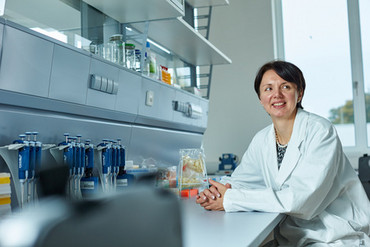Animal models and test systems
Central COFONI Technology Platform

For the interdisciplinary treatment of the SARS-CoV-2 research questions addressed in the various key areas, the University of Veterinary Medicine Hannover, Foundation (TiHo) provides all project partners within the network with state-of-the-art laboratories and animal housing for Biosafety Level 3 (BSL 3) experiments at the Research Centre for Emerging Infections and Zoonoses (RIZ) within the framework of cooperation projects. The extensive logistical equipment for BSL 3 animal husbandry and the great expertise and experience in dealing with corresponding pathogens such as SARS-CoV-2 make this TiHo facility a central partner in COFONI. The RIZ with its BSL 3 laboratories has a multi-level safety system including a thermal wastewater system and double HEPA filtration of individual laboratory tracts, which prevent the pathogens from escaping into the air. The technical systems and equipment were checked in a lengthy test phase, and workflows, maintenance, and emergency processes were intensively validated and trained. Since January 2020, the BSL 3 laboratory and also the Animal Biosafety Level 3 (ABSL 3) Facilities have started operations in handling human pathogenic aerosol transmissible pathogens. Extensive work in the BSL 3 laboratories at the RIZ is carried out by numerous renowned scientists under the coordination of Professor Maren von Köckritz-Blickwede as Head of Scientific Administration and Biosafety and Professor Albert Osterhaus as Scientific Director, a world-renowned expert in the field of coronavirus research especially regarding SARS-CoV-1 and MERS-CoV.
At the RIZ, various experimental animal models in ferrets, hamsters, and mice are also established in the BSL 3 laboratories and used for studies for testing vaccines and new antiviral strategies. The highest possible standards in terms of animal welfare and biosafety are required for performing these animal experiments. The scientists involved like Professor Asisa Volz, Professor Wolfgang Baumgärtner, Professor Maren von Köckritz-Blickwede, Professor Guus Rimmelzwaan, and Professor Albert Osterhaus have the professional expertise and also the institutional requirements with state-of-the-art building technologies to meet these standards.
To support the questions addressed in the COFONI research network, the previously established SARS-CoV-2 animal models will be further optimised for project-specific conditions under the leadership of Professor Volz and Professor von Köckritz-Blickwede as head of the technology platform in order to complement research results generated in patients in the best possible way. This includes the additional development of SARS-CoV-2 animal models that reflect particular pathophysiological conditions in humans, such as (1) specific pre-existing disease/immunosuppression, and (2) age or even long/post COVID pathologies. These models will be established within the central infrastructure and made available to the partners in COFONI including expertise in SARS-CoV-2-specific animal testing. As a partner, TiHo can provide the logistics and performance of animal experiments under BSL 3 conditions, including pathological examinations by the Institute of Pathology under the direction of Professor Wolfgang Baumgärtner, to all partners in COFONI within the framework of cooperation projects, thus providing a platform for regional research. This allows a fast implementation of testing of active substances and vaccines. The analysis performed in such animal models will be essential for using the data generated in COFONI for establishing new diagnostic methods as well as for developing new therapeutics and vaccines in humans.
Another essential part of this cross-site central project "Animal Models" is located at TWINCORE –Centre for Experimental and Clinical Infection Research and represented by Professor Ulrich Kalinke. Even before the central COFONI technology platform was established, a technology platform in the field of genetically modified mice was already in place, which is jointly supported and professionally organised by the Hannover Medical School (MHH) and the Helmholtz Centre for Infection Research (HZI). Mouse models of SARS-CoV-2 infection developed at TWINCORE are of particular importance for COFONI. Previously produced transgenic mice expressing the human receptor of SARS-CoV-2, angiotensin converting enzyme 2 (ACE2), which is an important enzyme in blood pressure regulation, and the renin-angiotensin system (RAS) will be combined with a tamoxifen-inducible deletion of the type I interferon receptor (IFNAR) on type II pneumocytes of the lung (Sftpc-CreERIFNARfl/fl). Thus, the infectivity with SARS-CoV-2 of type II pneumocytes, which are an important target cell of SARS-CoV-2 in the human lung, can be further increased in mice. In this way, quality-controlled transgenic mouse models of SARS-CoV-2 infection can be made available to the partners in COFONI for various questions.
Non-human primates (NHP) are genetically, immunologically, and physiologically more closely related to humans than rodents and ferrets and better represent certain aspects of COVID-19 disease than small animal models. Therefore, important hypotheses developed in cell culture and/or small animal models need to be tested in NHP models. In particular, the immune systems of NHP and humans show strong similarities. NHP are therefore particularly suited to elucidate which processes are important for the establishment of a protective immune response against SARS-CoV- 2 and how these processes are disrupted by the virus. With the help of NHP models, key insights into SARS-CoV-2 spread in the host and pathogenesis as well as its inhibition by vaccines, drugs and antibodies could already be gained at the start of the pandemic.1,2 Today, NHP models continue to be of great importance for the analysis of, among other things, candidate vaccines and recombinant neutralizing antibodies, and are used to study virus replication and pathology after the acute phase of infection. The Infection Biology Unit at the German Primate Center – Leibniz Institute for Primate Research (DPZ) is headed by Professor Stefan Pöhlmann and has made important contributions to the study of SARS-CoV-2 infection, including the discovery of ACE2 as a receptor for SARS-CoV-2 and TMPRSS2 as an activating protease.3 Together with the Laboratory Animal Science Unit, headed by Professor Rabea Hinkel, and partners at the TiHo, in particular Professor Albert Osterhaus, the Department of Infection Biology has established the SARS-CoV-2 infection of rhesus monkeys. This model reproduces a mild course of SARS-CoV-2 very well4 and has been successfully used to demonstrate, among other things, the antiviral effect of a recombinant neutralizing antibody. In parallel with the TiHo, models are being established to represent pre-existing diseases and immune deficiencies. In addition, methods based on vector technologies and DPZ-licensed virus like particle (VLP) technology5 will be established that allow targeted modulation of host cell factor expression in the respiratory tract. This approach can significantly contribute to identifying cellular factors as targets for COVID-19 therapy. The corresponding animal models will be established within the infrastructure and made available to partners in the consortium as part of a collaboration. In this context, the DPZ will take over the planning and execution of the NHP work, including the virological and immunological analysis of the animals, and will advise and assist in the submission of project applications for animal experiments.
Prior to testing in animal models, the efficacy of small molecule compounds and biotherapeutics must be demonstrated in target-based and cellular assays. Likewise, sufficient pharmacokinetic properties must be proven. In particular, the identification of good low molecular lead structures requires the profiling of a large number of compounds. The Helmholtz Centre for Infection Research (HZI) is a specialised centre for infection-related assays under S2 and S3 conditions within the European infrastructure EU OPENSCREEN. The existing infrastructure and technology were expanded as part of the COFONI project to profile active substances against SARS-CoV-2 in a cellular assay cascade. A plaque-based secondary assay is used in addition to a high-throughput primary assay in 384 microtiter plate format. Several cell lines and viruses are available. The infrastructure will profile compounds from the COFONI network and from other national and international partners. If larger numbers of active substances are found, these will be filtered and prioritised in accordance with industry standards based on chemical and biological data. In addition, bioanalytical capacity will be provided to determine drug concentrations and pharmacokinetic parameters from the animal models described above via high sensitivity quadrupole mass spectrometry.
1 Baum et al (2020), Science, https://pubmed.ncbi.nlm.nih.gov/33037066
2 Munster et al (2020), Nature, https://pubmed.ncbi.nlm.nih.gov/32396922
3 Hoffmann et al (2020), Cell, https://pubmed.ncbi.nlm.nih.gov/32142651
4 Rockx et al (2020), Science, https://pubmed.ncbi.nlm.nih.gov/32303590
5 Hoffmann et al (2016), Mol Ther Nucleic Acids, https://pubmed.ncbi.nlm.nih.gov/27003757
Contact
Animal models and test systems

Prof. Dr. Mark Brönstrup
Helmholtz-Zentrum für Infektionsforschung
Feodor-Lynen-Str. 7-9
30625 Hannover
Mark.Broenstrup(at)helmholtz-hzi.de

Prof. Dr. Ulrich Kalinke
Institut für Experimentelle Infektionsforschung
TWINCORE –Zentrum für Experimentelle und Klinische Infektionsforschung
Feodor-Lynen-Str. 7-9
30625 Hannover
Ulrich.Kalinke(at)twincore.de

Prof. Dr. Stefan Pöhlmann
Deutsches Primatenzentrum GmbH
Leibniz-Institut für Primatenforschung
Kellnerweg 4
37077 Göttingen
spoehlmann(at)dpz.eu

Prof. Dr. Asisa Volz
Institut für Virologie
Stiftung Tierärztliche Hochschule Hannover
Bünteweg 17
30559 Hannover
Asisa.Volz(at)tihohannover.de

Prof. Dr. Maren von Köckritz-Blickwede
Stiftung Tierärztliche Hochschule Hannover
Bünteweg 17
30559 Hannover
Maren.von.Koeckritz-Blickwede(at)tihohannover.de
Downloads
Guideline for the use of the technology platform Animal Models
The aim of the guideline on the use of the technology platforms is to enable and promote the scientific use of the data and biospecimens collected in COFONI projects. COFONI aims to maximise the benefits of the collected data and biospecimens for medical research.
This guideline includes the general regulatory purpose as well as specific regulations of the Technology Platform Animal Models (Chapter I) and general templates and recommendations for central elements of animal experiment applications to standardise the framework conditions for conducting animal experiments (Chapter II). The regulations made apply to all COFONI-funded projects and COFONI utilisation projects.